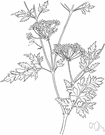co·ni·um
(kō′nē-əm)n.
The poison hemlock.
[Late Latin cōnium, from Greek kōneion, probably from kōna, liquid pitch.]
American Heritage® Dictionary of the English Language, Fifth Edition. Copyright © 2016 by Houghton Mifflin Harcourt Publishing Company. Published by Houghton Mifflin Harcourt Publishing Company. All rights reserved.
conium
(ˈkəʊnɪəm)n
1. (Plants) either of the two N temperate plants of the umbelliferous genus Conium, esp hemlock
2. (Pharmacology) an extract of either of these plants, formerly used to treat spasmodic disorders
[C19: from Late Latin: hemlock, from Greek kōneion; perhaps related to Greek kōnos cone]
Collins English Dictionary – Complete and Unabridged, 12th Edition 2014 © HarperCollins Publishers 1991, 1994, 1998, 2000, 2003, 2006, 2007, 2009, 2011, 2014
co•ni•um
(ˈkoʊ ni əm)n.
the poison hemlock, Conium maculatum.
[1860–65; < New Latin, Late Latin < Greek kṓneion]
Random House Kernerman Webster's College Dictionary, © 2010 K Dictionaries Ltd. Copyright 2005, 1997, 1991 by Random House, Inc. All rights reserved.
ThesaurusAntonymsRelated WordsSynonymsLegend:
| Noun | 1. |  Conium - small genus of highly toxic biennials: hemlock Conium - small genus of highly toxic biennials: hemlockrosid dicot genus - a genus of dicotyledonous plants Apiaceae, carrot family, family Apiaceae, family Umbelliferae, Umbelliferae - plants having flowers in umbels: parsley; carrot; anise; caraway; celery; dill Nebraska fern, poison hemlock, poison parsley, winter fern, California fern, Conium maculatum, hemlock - large branching biennial herb native to Eurasia and Africa and adventive in North America having large fernlike leaves and white flowers; usually found in damp habitats; all parts extremely poisonous |
Based on WordNet 3.0, Farlex clipart collection. © 2003-2012 Princeton University, Farlex Inc.